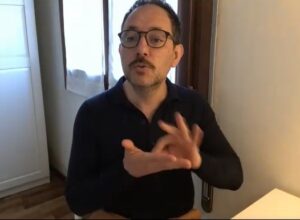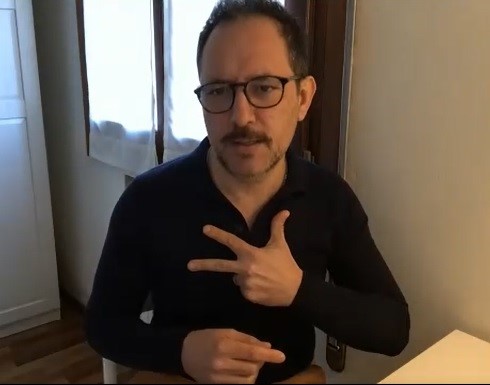GLIMPSES OF A DEAF PERSON’S CHILDHOOD
Mr. Caia is a Professor of Italian Sign Language at Ca’ Foscari University, in Venice. He was born in 1976 in Siracuse (Sicily) from deaf parents and he is deaf himself. In his family, they all use Italian Sign Language to communicate with each other. They found out about his deafness when he was attending nursery school in Siracuse and he wouldn’t speak. Therefore, his parents decided that it was better for him to attend an Institute for the Deaf, a type of school specifically meant for the education of deaf students.
LIFE INSIDE AN INSTITUTE FOR THE DEAF
An Italian Law issued in 1977 allowed deaf students, among other people with disabilities, to be admitted to public school, thus promoting social inclusion. But, as Mr. Caia’s parents had been educated in Sicilian Institutes for the Deaf, they wanted their son to live a similar experience. However, he did not stay in Sicily; he was actually enrolled at the Antonio Provolo Institute of Verona (northeast of Italy), in September 1980. “I was 3 or 4 at the time”, he recalls, “and I attended kindergarten and primary school there. I stayed there for 8 years”.
The Institute in Verona is divided into two dorms, located in different areas of the town, one for the male students and the other for the females. At the time, there were about 60 girls and 150 boys in the Institute, and “we would sleep and eat in the different branches, but we all attended school together”. In the school, there were hearing children as well, yet they only played with the deaf during the breaks, since their classes were differentiated. The Institute was run by priests – who taught Italian, Mathematics, and Art – and nuns. The lessons were given in Italian, therefore the children had to lipread and speak; they never used Italian Sign Language with the priests, even if they signed with each other. They also did speech therapy, to improve their speaking skills. From Monday to Friday, life in the Institute was repetitive: “we would get up at 7:00 a.m., pray and have breakfast. At 8:00 we had to be at school, we had lunch at 12:00, then played together till 2:00 p.m. We would go back to school until 4:00 p.m., then have a snack, do some homework and have dinner at 7:00. We would watch some TV and finally, go to bed at 9:00 p.m.”
THROUGH HAPPY AND PAINFUL MEMORIES
When Mr. Caia arrived at the Institute, he thought it was just a new school, but what he did not know was that children were not allowed to see their parents during the school year, and could only go home during holiday breaks. “It was a trauma for me” he explains “because when my mum left me at the Institute, she promised she would come back, but she did not. At Christmas, I headed back to Sicily and I was told that I had been sent there for my own sake, to receive a fine education, so I eventually accepted it, but I never liked my life there”. Furthermore, the atmosphere was always tense because of how authoritarian and frightening the priests were. Luckily, he managed to make friends among his peers, who became his family.
 Once he finished his last year of primary school, he moved to Padua and attended the Antonio Magarotto Institute for the Deaf until he finished high school. This Institute was very different from the one in Verona, for it was not run by priests and every teacher and educator signed. “I finally started to get over my trauma, it was a relief for me”. The teachers in Padua were supportive and even encouraged him to go to University. Nowadays, most deaf children attend public schools and many Institutes for the Deaf have been closing one by one over the past years. However, the Institute in Padua is still crucially important for the Deaf community in Italy.
Once he finished his last year of primary school, he moved to Padua and attended the Antonio Magarotto Institute for the Deaf until he finished high school. This Institute was very different from the one in Verona, for it was not run by priests and every teacher and educator signed. “I finally started to get over my trauma, it was a relief for me”. The teachers in Padua were supportive and even encouraged him to go to University. Nowadays, most deaf children attend public schools and many Institutes for the Deaf have been closing one by one over the past years. However, the Institute in Padua is still crucially important for the Deaf community in Italy.
When Mr. Caia thinks about his experience, he states: “I would never go back to the Institute in Verona and I do not want my children to attend any Institute at a very young age, because I want to take care of them. I would rather let them live this experience when they are teenagers so that they are older and more independent”.

